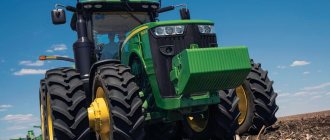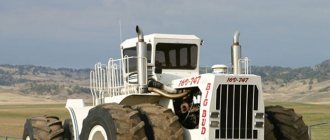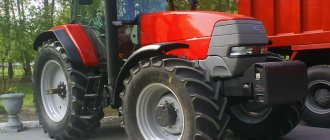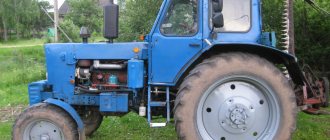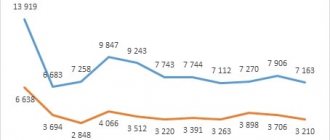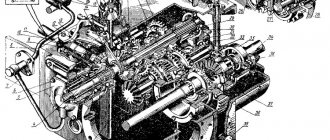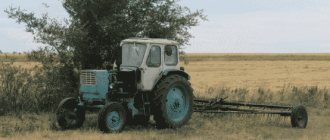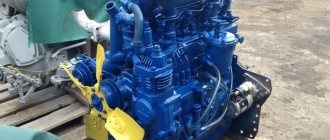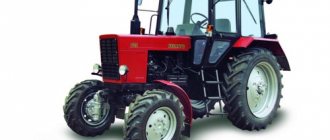This term has other meanings, see Tractor (meanings).
Tractor
(English tractor “tractor”) is a self-propelled (tracked or wheeled) machine that performs agricultural, road-building, earth-moving, transport and other work in conjunction with trailed, mounted or stationary machines (tools) [1]. Features low speed and high traction force. Widely used in agriculture for plowing and moving non-self-propelled machines and implements, as a rule, it is equipped with removable or non-removable mounted and semi-mounted equipment for agricultural, construction or industrial purposes (for example, drilling equipment) depending on the tasks performed. For example, an industrial tractor equipped with a bulldozer blade is called a bulldozer.
The word "tractor" comes from the English track
(the track is the main element of the caterpillar), “trace”[2][3].
The English word, in turn, goes back to the Latin trahere
, which means “to pull”, “to drag”[4][5].
The person driving the tractor, depending on the type, purpose, engine power, and additional equipment, is called: tractor driver, machinist, driver, machine operator.
In Russia, persons are allowed to operate any types of tractors only after completing training and having received a tractor driver (tractor driver) certificate from Gostekhnadzor[6].
Tractor structure[edit | edit code]
Main article: Tractor design
The main elements of a tractor: engine, transmission, chassis, control mechanisms, working and auxiliary equipment. Regardless of the type, the power plant of modern tractors is a diesel engine (previously gasoline, kerosene, gas generator, and oil internal combustion engines were also used). The steering device of wheeled tractors is similar to that of a car. To turn tracked tractors, one of the tracks is braked with a friction clutch.
Working equipment: Tractors are equipped with a hydraulic mounted system (HNS), which serves to connect the tractor with a mounted and semi-mounted machine, and control the operation of these machines. The hydraulic pump consists of two main parts: the attachment and the hydraulic system. Also, many tractors have a power take-off shaft (PTO), which is designed to drive working parts that are mounted [7] with tractors on mobile or stationary machines.
MTZ-80/82 "Belarus"
0
MTZ-80/82 “Belarus” is a brand of universal row-crop wheeled tractors produced by the Minsk Tractor Plant (MTZ) from 1974 to the present. The scope of application of MTZ-80 (82) tractors is quite extensive. They can be used for various jobs and are aggregated with mounted, semi-mounted, trailed and stationary machines. Farms and various enterprises have a large number of machines and mechanisms designed to work with tractors. The Minsk Tractor Plant successfully sells all over the world tractors developed on the basis of the MTZ-80, adapted for work in various climatic zones. The MTZ-82 modification has 4x4 all-wheel drive.
5.
Differences from other vehicles[edit | edit code]
The need to develop high traction force at low speeds determines many features of the tractor design. Thus, diesel engines are preferably used in tractors, including because they are capable of producing high torque at relatively low rotation speeds. Tractor engines in most cases are designed to operate for a long time at a constant speed and high load.
The tractor gearbox usually has a large number of gears in order to ensure engine operation in the optimal speed range under different loads and travel speeds. Tractors can also use torque converters or even electric transmission.
The need to realize a large traction force requires the use of a propulsion device appropriate for the task. In most cases, tractors are designed to operate on surfaces not suitable for vehicle traffic and may not be designed for use on public roads. The most common are wheeled tractors, in which the drive or all wheels have a large contact area with the surface and lugs, as well as tracked and half-tracked ones. To increase traction force, ballast weight is used.
Various mounted and trailed units, as well as working parts, are aggregated with tractors. Some of them require an energy supply to operate. For this purpose, power take-off shafts are installed on tractors, as well as a hydraulic pump that creates pressure for the operation of hydraulic drives.
K-700/701 "Kirovets"
0
See all photos in the gallery
The first tractor left the assembly shop and entered the fields of the country on July 13, 1962. Mass production began in 1969. It consists of front and rear semi-frames connected by vertical (to ensure the tractor turns) and horizontal (to ensure contact with the soil of all four wheels) hinges. With an engine power of 220 hp. with., making it possible to use wide-cut implements, the K-700 increased the productivity of agricultural work by 2.5-3 times compared to other tractors. The K-700 was developed as a dual-use product: in wartime it was supposed to be used as an artillery tractor. Many years of experience in operating the machine in various conditions and climatic zones have shown high reliability, simplicity and ease of maintenance, maintainability and long service life. On February 1, 2002, the St. Petersburg Tractor Plant ceased production of the Kirovets K-700A and K-701 tractors with the note that they were morally obsolete.
2.
Tractors by type of propulsion[edit | edit code]
Tractors use two types of propulsion systems - wheeled and tracked. Both types have advantages and disadvantages.
Wheeled tractor[edit | edit code]
Modern wheeled tractors can be used on public roads, where they can reach relatively high speeds. However, their adhesion to the ground is limited, and therefore the traction force is limited. On loose soil, such tractors may slip. To eliminate this drawback, tractors with all-wheel drive were created, but such machines are heavy and when moving across the field they compact the ground too much. To reduce pressure on the soil, the width of tractor tires has recently increased (especially heavy models are equipped with double or even triple wheels, usually on both axles). Some wheeled tractors have the ability to switch to half-tracks, as well as low-pressure tires for working on waterlogged and loose soils.
Crawler tractor[edit | edit code]
Tracked tractors have greater traction force than wheeled ones. The main disadvantage of most tracked tractors is the inability to move on asphalt roads without destroying the surface, with the exception of tractors with rubber cord tracks. The low speeds of crawler tractors (5-40 km/h) are compensated by reduced pressure on the ground due to the large area of contact with the ground, with the same mass as a wheeled tractor. Crawler tractors are widely used in agriculture, on weak soils and in industry due to their unpretentiousness. Depending on their purpose, tractors differ significantly in design solutions.
Defense (army) tractors
Military tractors are similar to general-purpose special equipment because they are used to transport various implements and trailers. They are also characterized by high cross-country ability (can be used on rough terrain and soils with weak load-bearing properties) and high traction force.
Also, many models of army tractors have an armored body. And among the attachments there are not only bulldozer blades, manipulators or loaders, but also, for example, installations for demining areas.
Image source tespa.ru
For obvious reasons, the exact models of army tractors are not disclosed. Moreover, often such special equipment is simply a defense modification of agricultural, industrial and skidding equipment. In Russia, many models of army tractors are produced by St. Petersburg.
Classification of tractors by purpose[edit | edit code]
Agricultural tractor[edit | edit code]
The peculiarities of operating tractors in agricultural work, namely, the seasonality of work and large cultivated areas, impose the following requirements on the design of the tractor:
- the ability to quickly change attachments and trailed equipment;
- the ability to work and move at high speeds while maintaining the ability to work with some machines (for example, potato diggers) at extremely low speeds;
- the need to unify connecting devices for various models of tractors and mounted machines;
- Possibility of maintenance and repair in the field.
Therefore, the following solutions are used in the design of agricultural tractors:
- engine with increased speed;
- multi-speed gearbox;
- possibility of installing a creeper;
- sprung suspension;
- unified rear linkage system (pendulum, lever-pendulum, lever);
Agricultural tractors produced in the USSR, depending on the traction force on the hook (in ton-force), were divided into classes [9]: 0.2 (“Rioni”); 0.6 (T-25); 0.9 (T-28X4, T-40); 1.4 (MTZ-50, YuMZ-6, MTZ-80, MTZ-82); 2.0 (T-54S); 3.0 (DT-75, DT-75M, T-150, T-150K); 4.0 (T-4A); 5.0 (K-700, K-701); 6.0 (T-130).
- Unified pendulum hitch of an agricultural tractor (with a fixed water pump of the sprinkler unit)
- Unified pendulum hitch for an agricultural tractor. Narrow wheels ensure movement between rows
- Chassis of the high-speed caterpillar tractor DT-75
- The track of a row crop tractor is set exactly as a multiple of the row spacing
- Plowing tractor. Each axle has 6 wheels
Agricultural tractors are divided into row crop and general purpose tractors.
- Row-crop tractors are designed for post-plow cultivation of soil and crops; they are used for haymaking, harvesting vegetable and forage crops. They can plow light soils in gardens and greenhouses. A distinctive feature of a row-crop tractor is its cross-row maneuverability. There are several inter-row cultivation schemes that determine the layout of a row-crop tractor.
Narrow-sized row-crop tractors have an overall width less than the row spacing and high ground clearance. They are used in the cultivation of fruit and berry trees and shrubs, as well as tall-stemmed vegetable crops. Narrow-sized row-crop tractors include, for example, gardening and vineyard modifications of the T-38 and T-70 tractors. Walk-behind tractors and walk-behind cultivators are also a type of narrow-sized row-crop tractors. High-clearance row crop tractors have a highly raised frame that moves over rows of plants. The chassis of such tractors is narrow, which makes it possible to reduce the row spacing. Depending on the number of rows of plants located under the frame of the tractor, single-row, double-row and multi-row processing is distinguished. For cultivating most crops, a ground clearance of 450 mm is sufficient. On the other hand, with such ground clearance, the tractor still has sufficient stability, which allows it to be used for other work. Row-crop tractors with a ground clearance of about 450 mm are called universal row-crop tractors
. Versatility implies both the ability to cultivate various crops and perform various tasks. An important feature of universal row-crop tractors is the ability to adjust the track width.
In addition to universal row-crop tractors, specialized high-clearance row-crop tractors are also produced. In particular, cotton-growing tractors have a three-wheeled chassis and ground clearance from 650 mm to 1500 mm.
Universal row-crop tractors can be used to perform other work and to drive stationary machines. Universal row-crop tractors are mainly wheeled. The energy intensity of universal row-crop tractors ranges from 18 to 60 horsepower per ton of traction.
General purpose tractors are divided into arable and transport.
- Plowing tractors are designed for continuous plowing of soil in fields. Arable tractors produced in the USSR had
- traction class from 3 to 10 ton-force and energy intensity from 25 to 30 horsepower per ton-force of traction. Crawler tractors plow at speeds of 6-10 km/h, and wheeled tractors - 10-20 km/h. Plowing tractors have a center of gravity shifted forward. This is necessary in order to evenly distribute the weight over the entire length of the track when working with the plow.
- Transport tractors are only wheeled. Designed for transporting agricultural goods on trailers. They have high operating speeds - up to 50 km/h (T-150). Transportation of agricultural goods by transport tractors is less expensive than by off-road trucks of similar carrying capacity. General purpose wheeled tractors combine the functions of arable and transport. General purpose tractors have lower ground clearance compared to row crop tractors.
Lately, row-crop tractors have become widespread, the chassis of which allows the installation of narrow wheels for row-crop work, wide wheels for transport work, and twin wheels for plowing.
Due to the great versatility of agricultural tractors, they are also the base machines for light construction bulldozers and municipal vehicles.
In the USSR, a number of agricultural tractors (T-74, MTZ-82, T-150K, K-700) had industrial modifications to work with trailed scrapers, graders, loaders and other construction and road machines requiring increased operating speeds.
Industrial tractor[edit | edit code]
An industrial tractor is designed to work as a base machine in an earthmoving or construction unit: bulldozer, scraper, pipe layer. The industrial tractor is characterized by the following features:
- operation during the entire service life with the same type of working equipment;
- work at low speeds with high traction force in conditions of chassis slipping;
- the ability to work on hard (including rocky) soils;
- possibility of working on waterlogged soils;
- the need for precise positioning of the working element relative to the ground;
- delivery to the work site using special transport.
- Bulldozer-loosening unit B-10 based on the industrial tractor T-170
- To improve the driver's visibility of bulldozer equipment, the T-330 industrial tractor has a front-mounted cab. A relatively rare technical solution
- DET-250M is one of the few tractors in the world with an electromechanical transmission
- A rigid suspension and reinforced track help the tractor work on hard soil. For towing trailed earth-moving machines (scraper, grader), the tractor has a towing device
- Bulldozer-ripper unit Caterpillar D9 (USA)
The design of industrial tractors is distinguished by the following solutions:
- low-speed engine with high torque;
- use of a torque converter on tractors of traction class 15 and above.
- gearbox with constant mesh gears lubricated under pressure;
- rigid (or semi-rigid) suspension;
- reinforced chassis and frame;
- armored hood and lower part of the engine compartment to protect the engine from stones falling over the dump;
- the presence of reinforced hinges for attaching the blade, ripper and hydraulic cylinders;
- hydraulic equipment with increased energy intensity;
- improved forward visibility from the cab;
- ability to work at low temperatures.
A distinctive feature of industrial tractors is their center of gravity shifted back. This is necessary so that, within the bulldozer unit (the weight of the blade can be up to 20% of the weight of the tractor), the weight distribution over the entire length of the tracks is uniform. Therefore, when using a tractor without a bulldozer blade, a counterweight is installed on the front of the frame.
The low operating speeds (2-3 km/h) of industrial tractors determine their relatively low energy consumption - about 15 horsepower per ton of traction.
For industrial tractors, a hydromechanical transmission is optimal, allowing full engine power to be realized at particularly low speeds. There are tractors with electric transmission (for example, DET-250M. DET-320).
Unlike agricultural tractors, industrial ones are highly specialized, initially designed to work as part of a specific type of machine (usually a bulldozer-ripper unit).
Industrial tractors are mainly tracked, but wheeled tractors (mainly modifications of agricultural tractors) are also used to operate loaders and some road machines.
In the USSR, on the basis of industrial tractors, agricultural tractors were created for plowing virgin lands (T-100MGS, T-130, T-170), which were distinguished by the installation of an agricultural-type rear linkage.
Skidding tractor[edit | edit code]
The skidder is designed to transport tree trunks from the felling site to the intermediate storage site. Skidders are usually built on the basis of agricultural tractors and differ from them in their layout, which allows placing on the rear of the frame a platform with a winch for checker skidding of forest (for example TDT-55, TT-4) or a hydraulic grip for checkerless skidding of forest (for example LT-187 on chassis TT-4M). A distinctive feature of skidders is the chassis with a large supporting area, which reduces the erosive effect on the forest floor.
In Russia, skidding tractors are produced by the Onega Tractor Plant. Barnaul produces several variants of skidding tractors: TSN-4, TT-4M with a single or double cabin, with a YaMZ and A-01 engine, a reinforced chassis system, various technological equipment, Altai Special Engineering Plant ( AZSM) "PROGRESS" produces the skidding tractor MSN-10 (an improved analogue of the TT-4M), as well as other modifications of this tractor with various technological equipment: LP-18K, LT-188 (forestry jaw loader), LT-187 and forest fire tractor MSN -10 PM "RUBEZH 4000".
Army tractor[edit | edit code]
Previously, tractors were used in combat units of the armies of many countries. Widely used in the First World War. The army tractor is designed to tow artillery pieces and other trailed weapon systems. The main requirements for army tractors are high speed on a forced march, high maneuverability, and adaptability to work in various climatic conditions. Army tractors were, as a rule, modifications of agricultural and skidding tractors. During the Second World War, a number of warring armies (including the Red Army) used armored tractors, which were equipped with cannon weapons or Katyusha multiple launch rocket systems (for example, STZ-5-NATI). In modern conditions, they are used extremely rarely, since in terms of tactical and technical characteristics they are inferior to modern off-road tractor vehicles. In the USSR army, starting from the 50s, tractors were used only in the engineering troops, although in the armies of NATO countries they are still used to a limited extent for transporting artillery pieces in difficult terrain.
Frame types and designs
- Frameless
- Semi-frame
- Frame
- Monohull
- Sectional with articulated sections
An example of frame tractors is the forestry machines of the Onezhets family, where the frame is a welded structure of longitudinal metal beams and tubular transverse beams, on which the engine, cabin, body and all transmission components rest. Heavy tracked industrial tractors from the Chelyabinsk Tractor Plant (T-100, T-130, T-170 and others) also have a frame type of frame.
T-130 crawler tractor frame
The most popular design is semi-frame. The frame is a composite structure with a front part in the form of a beam half-frame, which is attached to the transmission housing of the machine. The range of vehicles with this type of frame includes the following brands of well-known wheeled self-propelled vehicles: MTZ, LTZ, VTZ, YuMZ.
Semi-frame tractor base
Examples of tractors with a frame in the form of articulated sections (semi-frames) are the T-150K wheeled tractor, tractors of the Kirovets family (K-700, K-701, K-702 and others).
Articulated frame T-150K
Frameless and monohull types of frames are rarely used in the design of tractors and are not found among popular models in use.
History[edit | edit code]
Invention[edit | edit code]
The first tractor-like machines appeared in the 19th century and were steam-powered. So, back in 1850, the English inventor William Howard used a locomobile for plowing. In the second half of the 19th century, about two thousand of these machines were already working in the fields of Great Britain. In 1892, John Frohlich of Clayton County, Iowa, USA, invented, patented and built the first petroleum-powered tractor.
The first steam crawler tractor in the world can probably be considered the invention of the Englishman John Gitcot [en] (inventor of the industrial loom) in 1832 (patent) and the construction in 1837 of a working copy of the machine designed for plowing and draining English swamps. In 1858, the American WP Miller invented and built a caterpillar tractor, with which he participated in the agricultural exhibition of the city of Marysville (California) in 1858 and received a prize for the original invention (patent from 1859 US N23853 Warren P. Miller). Neither Gitkot's invention nor Miller's tractor received further development. The first recognized practical tracked vehicle was the Lombard Steam Log Hauler by inventor Alvin Orlando Lombard in 1901.
In Russia, the first application for a “carriage with moving tracks,” that is, a caterpillar track, was made in 1837 by a Russian peasant, later a staff captain of the Russian army, Dmitry Zagryazhsky. This is how he described his invention: “Near each ordinary wheel on which the carriage rolls, there is an iron chain, tensioned by hexagonal wheels located in front of the ordinary one. The sides of the hexagonal wheels are equal to the chain links; these chains replace to some extent the railway, providing the wheel with always a smooth and hard surface” (from a privilege issued in March 1837) [10].
According to unreliable sources, the first Russian steam crawler tractor was built by a native of the village of Nikolskoye, Volsky district, Saratov province, peasant Fedor Abramovich Blinov. According to documents, in 1879 he received a patent (“privilege”) for “a car with endless rails for the carriage of goods on highways and country roads” and soon built such a crawler car for horse-drawn use. Blinov also gave a presentation on “A steam locomotive with endless rails for country roads” at the Nizhny Novgorod exhibition in 1896[11]. Writer Lev Davydov (real name Lomberg) claimed that the construction of a prototype (self-propelled) tractor was completed by Blinov in 1888. A ready-made steam engine of small dimensions did not yet exist, and Fyodor Abramovich himself built it from sheet iron and pipes of a steamship that burned down near Balakovo. Then he made the same second machine. They both made forty revolutions per minute. Each of them was controlled separately. The speed of the tractor corresponded to the speed of the bulls - three miles per hour. Thus, the device was powered by two steam engines (one for each “caterpillar”) with a power of 10-12 horsepower each. F.A. Blinov demonstrated it in 1889 in Saratov and in 1897 at the Nizhny Novgorod Fair. However, this tractor never became in demand either in industry or in agriculture, and things did not go beyond the prototype of tractors in Russia.[12] Despite the widespread opinion that Blinov built a tractor, there is not a single documentary evidence of this in the archives or anywhere else, there is only evidence of his construction of a horse-drawn tracked carriage. There is no information about Blinov’s construction of a self-propelled device before Lev Davydov’s publications. (For more details, see Blinov, Fedor Abramovich)
In 1896, Charles W. Hart and Charles Parr developed a two-cylinder gasoline engine. In 1903, their company built 15 tractors. Their six-ton #3 is the oldest internal combustion engine tractor in the United States and is housed in the Smithsonian National Museum of American History in Washington, DC. The two-cylinder petrol engine had a completely unreliable ignition system and a power of 30 hp. With. at idle and 18 l. With. under load[13].
The first practical one was Dan Alborn's 1902 Ivel three-wheel tractor. About 500 of these light and powerful machines were built.
In 1912, the German company Hanomag began producing tractors. In the same year, it began producing caterpillar tractors. This vehicle was not tracked in the full sense of the word, since metal bands were placed only on the rear support wheels, and ordinary wheels were left in front of this vehicle. In 1913, at the All-Russian Exhibition in Kyiv, where “Holt” was exhibited, Russian experts determined its inferiority. took into account the instructions of Russian engineers and converted the entire tractor to caterpillar tracks in 1914-1915.
Implementation[edit | edit code]
In 1917, mass production of Fordson tractors began in the United States at Ford factories.
In Russia, only the Soviet government after 1917 appreciated the importance of tractors for the country, allocating money for the construction of tractors during the difficult years of intervention for the country. Starting from 1918, on the instructions of V.I. Lenin, production preparations for the production of tractors were carried out. In 1919, inventor Ya. V. Mamin created the Gnome tractor with an 11.8 kW oil engine. The production of tractors was so important that the Decree of the Council of People's Commissars of April 1, 1921 was issued recognizing agricultural engineering as a matter of extreme national importance. In 1922, Kolomenets-1 tractors designed by E. D. Lvov began to be produced. In 1922-1923, the Zaporozhets tractor was created under the leadership of engineer L. A. Unger. In 1923, the Tokmak plant began producing the first tractors in the USSR[14].
In 1924, the USSR began production of three models of tractors: “Kommunar” (Kharkov Locomotive Plant) and “Fordson-Putilovets” (Krasny Putilovets). In 1930, the Stalingrad Tractor Plant and the Kharkov Tractor Plant were founded, and in 1933, the Chelyabinsk Tractor Plant Since 1934, the Universal tractor (a copy of the Farmall F-20[en] tractor from the American company International Harvester) with a kerosene engine and metal wheels began to be produced in Leningrad.The Universal was the first domestic tractor exported abroad.
Despite the preserved pre-revolutionary production base (five factories suitable for the manufacture of tractors) and the presence of its own developments (tractors “Gnome”, “Kolomenets-1”, “Karlik”, “Zaporozhets”, “Kommunar”), Soviet industry was unable to give agriculture neither a sufficient number of tractors nor the quality of products. In 1924-25 it was planned to produce 1,120 tractors, but this plan was not fulfilled. In 1925-26, it was planned to produce 1,800 tractors of all types (with the simultaneous purchase of 14,950 machines abroad), but in fact less than 900 tractors were produced, most of which “fell apart after several weeks or months of work”[15]. Nevertheless, in this way the foundations of domestic tractor construction were laid and the first cadres of tractor builders were trained. Further development of the country required the construction of large specialized tractor factories. Using the currency received from the sale of grain, timber, oil and petroleum products, with the help of American and European engineers and the supply of equipment from several hundred foreign companies, the following were built: the Stalingrad Tractor Plant in 1930 (produced STZ-15/30 tractors (McCormick Deering 15- 30, International Harvester), Kharkov Tractor Plant in 1931 (produced KhTZ tractors, similar to STZ tractors), Chelyabinsk Tractor Plant in 1933, produced S-60 (Caterpillar Sixty) tracked tractors. During the ten pre-war years, domestic industry produced for agriculture about 700 thousand tractors.The total production of domestic tractors amounted to 40% of their world production.
During the Great Patriotic War, the Altai Tractor Plant was built, and in the post-war years, factories were built in Minsk, Vladimir, Lipetsk, Chisinau, Tashkent, and Pavlodar.
DT-75
0
DT-75 is a general-purpose crawler agricultural tractor. The most popular caterpillar tractor in the USSR. In 2013, the Volgograd Tractor Plant celebrated the half-century anniversary of the start of production of the DT-75. The tractor has acquired a good reputation thanks to a successful combination of high performance properties (simplicity, efficiency, maintainability) and low cost. Initially, the tractor was equipped with a closed automobile-type cab: an all-metal, two-seater sealed cabin, unified with the cab of the GAZ-51 car. The seat is adjustable according to the weight and height of the driver. The DT-75M tractor had a cab with a deeper height of the cab ceiling and control levers bent towards the tractor driver. The number of vehicles coming off the assembly line is more than 2.7 million. In everyday life, the DT-75 tractor with a fuel tank located on the side of the cab is often called the “postman”.
4.
Technical characteristics of the snow removal tractor
It doesn’t matter for what purpose the equipment is chosen - clearing snowdrifts at the dacha or cleaning city streets and highways. There are certain requirements for this type of machine.
- The engine power of a tractor for cleaning snowdrifts should be in the range of 10-25 hp. With a lower power limit, equipment is used to work on freshly fallen snow. Medium-power (universal) machines work on dense snow cover on access roads to courtyards and indoor areas. Utility tractors with engines 20-25 hp. used for clearing snow with a dense mass of 40-50 cm.
- Snow removal tractors are gasoline-powered models. Diesel versions are cheaper to operate, but can stall in cold weather.
- For better cross-country ability, all-wheel drive versions are chosen, although for small volumes you can use rear-wheel drive vehicles.
- In snowdrifts, it is preferable to work on tractors with a manual transmission, which ensures smooth movement.
- The weight of the machine is chosen based on 1 hp. for 50 kg of equipment. Mini versions weighing 1-1.2 tons can work on freshly fallen snow.
Clearing the area of snow with a tractor requires the use of special equipment:
- blade with brush. The blade is placed in front, it shovels the snow to the side, the brush is placed in the back, it removes the remaining cover. To be able to clear snowdrifts at different angles, the blade must be equipped with a hydraulic drive;
- a bucket that replaces a blade. Used for loading collected snow into vehicles for removal;
- auger for crushing the compacted formation;
- grader blade working together with the blade.
Tractors of traction class 0.6
Tractors and self-propelled chassis of traction class 0.6 (Belarus-320, T-30A, KhTZ-2511, VTZ-30SSh, SSh-25, T-16MG, etc.) are used for inter-row and pre-sowing cultivation, sowing, planting vegetable crops and gardens, crop care, hay harvesting, transport work and can operate stationary machines.
Self-propelled chassis is a type of tractor on the frame of which a loading platform for transporting goods is mounted or working parts of agricultural machines and implements, as well as units for work in public utilities, are mounted. Self-propelled chassis SSh-25 and T-16MG are used in vegetable growing, horticulture, field farming and livestock farming.
Foreign modern tractors
If, for comparison, you look at agricultural machines produced abroad, you can pay attention to the tractor produced by , which developed and created the John Deere tractor.
John Deere is a universal tractor created by a manufacturer specializing in wide-ranging agricultural equipment, and especially an excellent line of new generation tractors. Their machines were exhibited at international exhibitions and proved to be of very high quality and productivity.
Many international agricultural organizations have adopted these tractors, having secured a guarantee of reliability and quality, since this company has been working on the production of agricultural equipment for almost 170 years. The transmission and engines on these tractors are produced at the same plant, and to optimize labor, modern innovations are constantly being introduced into the development of new models, ensuring increased productivity and comfortable working conditions.
Comparing these three tractor models, we can say that both John Deere and Kirovets are not inferior to each other in high performance and improvements. The only question is in the area of application, since John Deere and Kirovets are intended to be used for large production volumes, where higher power is needed. The same tractor as the Belarus - 132 H can be used for small jobs limited to private land, and therefore its power is commensurate with the purposes of its use.
Who should apply the markings?
The mark of conformity, marking plate and operational description will be applied and filled out by domestic manufacturers of special equipment. If products are imported into the territory of the Eurasian Union from abroad, such responsibility falls on the importer. Since all information and documentation must be translated into Russian, the importer will also have to do this.
You can learn more about the nuances of marking equipment for agriculture and forestry from our specialists. Call us, we will advise you free of charge if you have any questions!
Tractors of traction class 0.2
Mini-tractors of traction class 0.2 (T-012, AMZhK-8, MTZ-082, MT-15, etc.) are designed for work in small-circuit, selection fields and on farms. They can be combined with a plow, mower, cultivator, trailed cart and other implements and machines made specifically for them.
A mini-tractor, or small-sized tractor, is a universal mobile power vehicle with a two-axle wheeled chassis or tracked propulsion.
The walk-behind tractor is a universal mobile power tool based on a single-axle chassis, controlled using rod levers by the operator following behind. Conventionally, the walk-behind tractor can be classified as traction class 0.1.
